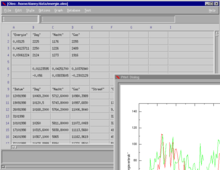|
GNU Oleo
GNU Oleo is a discontinued[4] lightweight free software spreadsheet[5] originally designed as a text-based spreadsheet using the curses library. The last development version of Oleo, 1.99.16, was released in 2001. HistoryThe project was started in 1992 by Tom Lord,[1] and became part of the GNU initiative around 1994.[6] At the time, the only open source alternative was the older text-based sc, both products having similar functionality to early versions of Lotus 1-2-3 or Microsoft Excel. Oleo's key bindings however were inspired from the Unix world, and similar to those used by the emacs editor, which frustrated novice users familiar with the DOS counterparts.[7] Oleo and sc were the first Unix spreadsheet applications to acquire a graphical user interface.[8] Because Oleo was officially part of the GNU project, it was dubbed "GNU's response to Excel" in a 1996 article in iX magazine.[9] It claimed to be "better than the high priced spread",[10] a reference to old oleomargarine advertisements promoting margarine over the more expensive butter. Oleo also worked well in a BSD environment; a FreeBSD port was available.[6] By 1995, sc had acquired an X Window front-end called xspread, which added graphics capabilities.[7] In 1998,[1] Oleo acquired a Motif-like GUI, relying on the royalty-free LessTif widget set. A GTK version was also under development. By 1999 Oleo was still judged as "not completely usable",[11] due to the awkward graphical interface lacking in user friendliness like X-style cut, copy, and paste or tear-off menus.[8] In the 1995 version, to type a number into a cell the user had to hit the "=" key first, similar to the early versions of Excel.[7] This was later changed to typing a number directly, although typing a number in a cell that already contains one appends to it rather than overwrite it.[12] Graphics are drawn using the device-independent library libplot, the centerpiece of the GNU plotutils. Oleo offers spreadsheet access to the GNU Scientific Library, a large collection of mathematical functions. It also offers some database connectivity, allowing access to MySQL database via queries, Xbase and DBF file access.[6] It has support for macro programming, and for printing purposes it supports ASCII and PostScript output.[13] Still, by 2000 it could not import Excel spreadsheets, while newer open source alternatives like Gnumeric offered this feature,[6] and could also import Oleo spreadsheets.[14] Oleo was still recommended as a console spreadsheet application in a 2005 article in Linux.com, but the reviewer warns that "I had expected Oleo to be more intuitive, but I needed multiple sessions with the info file before I could use it proficiently. Even cell reference syntax was not what I had expected."[13] By default, Oleo uses numbers for both rows and columns; a cell reference uses a syntax like References
External links
|
||||||||||||||||||
